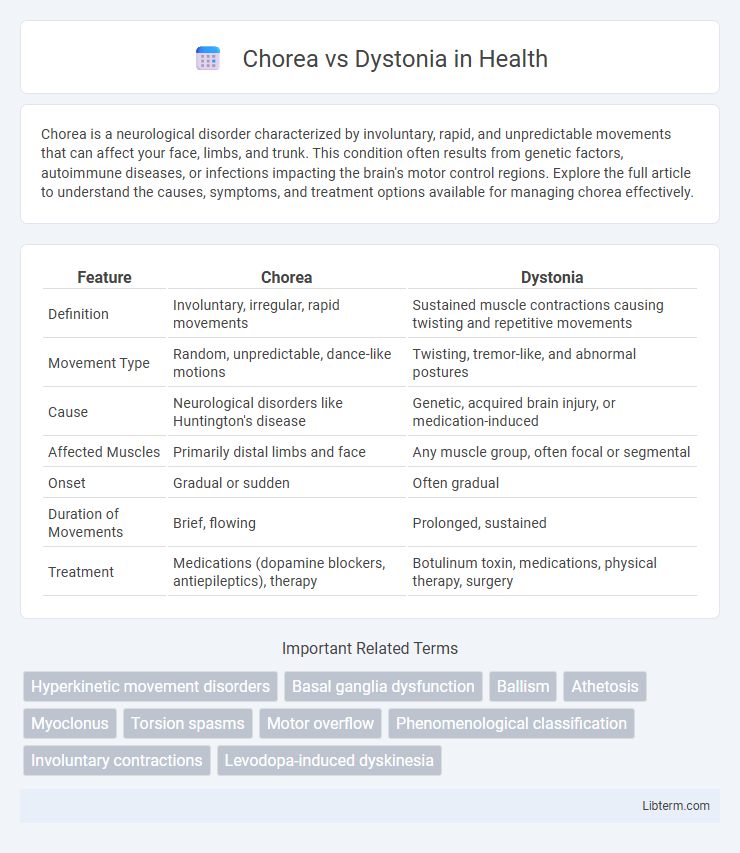Chorea is a neurological disorder characterized by involuntary, rapid, and unpredictable movements that can affect your face, limbs, and trunk. This condition often results from genetic factors, autoimmune diseases, or infections impacting the brain's motor control regions. Explore the full article to understand the causes, symptoms, and treatment options available for managing chorea effectively.
Table of Comparison
| Feature | Chorea | Dystonia |
|---|---|---|
| Definition | Involuntary, irregular, rapid movements | Sustained muscle contractions causing twisting and repetitive movements |
| Movement Type | Random, unpredictable, dance-like motions | Twisting, tremor-like, and abnormal postures |
| Cause | Neurological disorders like Huntington's disease | Genetic, acquired brain injury, or medication-induced |
| Affected Muscles | Primarily distal limbs and face | Any muscle group, often focal or segmental |
| Onset | Gradual or sudden | Often gradual |
| Duration of Movements | Brief, flowing | Prolonged, sustained |
| Treatment | Medications (dopamine blockers, antiepileptics), therapy | Botulinum toxin, medications, physical therapy, surgery |
Introduction to Chorea and Dystonia
Chorea and dystonia are movement disorders characterized by involuntary muscle contractions affecting motor control. Chorea presents as rapid, irregular, and unpredictable muscle jerks, commonly associated with conditions like Huntington's disease. Dystonia involves sustained or repetitive muscle contractions causing twisting or abnormal postures, often linked to genetic factors or neurological injury.
Defining Chorea: Symptoms and Causes
Chorea is characterized by rapid, involuntary, irregular movements that flow randomly across different muscle groups, often associated with neurological disorders such as Huntington's disease and Sydenham's chorea. Symptoms include abrupt, unpredictable jerks affecting the face, limbs, and trunk, with underlying causes linked to abnormalities in the basal ganglia and dopamine regulation. Unlike dystonia, which involves sustained muscle contractions and repetitive twisting motions, chorea's hallmark is its brief, dance-like movements triggered by neurodegenerative or autoimmune factors.
Understanding Dystonia: Key Features and Triggers
Dystonia is a movement disorder characterized by sustained or intermittent muscle contractions causing abnormal, often repetitive movements or postures, distinct from the rapid, unpredictable movements seen in chorea. Key features include muscle twisting, tremors, and writing difficulties, with symptoms often worsening during voluntary actions or stress. Common triggers include fatigue, anxiety, sensory stimuli, and certain medications, making early diagnosis and tailored management critical for improving patient outcomes.
Pathophysiology: Comparing the Underlying Mechanisms
Chorea results from dysfunction in the basal ganglia, particularly the striatum, causing excessive, irregular, and involuntary movements due to imbalance between direct and indirect pathways. Dystonia involves abnormal muscle contractions triggered by abnormalities in the basal ganglia and sensorimotor cortex, leading to sustained or repetitive muscle contractions and abnormal postures. Both disorders share basal ganglia involvement but differ as chorea stems from hyperkinetic activity, while dystonia is characterized by defective sensorimotor integration and altered neural plasticity.
Clinical Presentation: How Chorea Differs from Dystonia
Chorea is characterized by rapid, irregular, and involuntary jerky movements that flow unpredictably from one muscle group to another, often seen in Huntington's disease. Dystonia, in contrast, presents as sustained or intermittent muscle contractions causing abnormal, repetitive movements or postures, frequently involving twisting and patterned movements. While chorea movements are typically sporadic and non-rhythmic, dystonia movements tend to be more prolonged and may worsen with voluntary actions or stress.
Diagnostic Criteria and Assessment Tools
Chorea is identified by rapid, irregular, involuntary movements that flow unpredictably across different body parts, while dystonia presents as sustained or intermittent muscle contractions causing abnormal postures or twisting movements. Diagnostic criteria for chorea often rely on clinical observation combined with genetic testing for conditions like Huntington's disease, whereas dystonia diagnosis involves detailed clinical examination supported by neuroimaging and electrophysiological studies to exclude secondary causes. Assessment tools include the Unified Huntington's Disease Rating Scale (UHDRS) for chorea severity and the Burke-Fahn-Marsden Dystonia Rating Scale (BFMDRS) to quantify dystonia's motor impact.
Common Causes and Associated Disorders
Chorea is commonly caused by Huntington's disease, rheumatic fever, and certain autoimmune conditions, with associated disorders including Sydenham's chorea and lupus. Dystonia often arises from genetic mutations, brain injuries, or side effects of medications, with related conditions such as Wilson's disease and Parkinson's disease. Both movement disorders involve disruptions in basal ganglia function but differ in etiology and clinical presentation.
Treatment Options: Therapies for Chorea vs Dystonia
Treatment options for chorea primarily include dopamine-depleting agents such as tetrabenazine and deutetrabenazine, which help reduce involuntary movements by modulating neurotransmitter activity. Dystonia therapy often involves botulinum toxin injections to relax overactive muscles, alongside oral medications like anticholinergics and muscle relaxants to improve motor control. Deep brain stimulation is an effective surgical option for both conditions when pharmacological treatments prove insufficient, targeting specific brain areas to alleviate symptoms.
Prognosis and Long-term Outlook
Chorea typically presents with rapid, involuntary movements and often arises from genetic conditions like Huntington's disease, which generally has a progressive course leading to significant functional decline over time. Dystonia involves sustained muscle contractions causing twisting and repetitive movements or abnormal postures, with prognosis varying widely depending on the type, ranging from manageable symptoms in focal dystonias to more disabling effects in generalized forms. Long-term outlook for chorea is usually poorer due to its association with neurodegenerative disorders, whereas dystonia patients may experience stable or improving symptoms with appropriate therapies such as botulinum toxin injections or deep brain stimulation.
Conclusion: Key Differences and Clinical Implications
Chorea is characterized by rapid, involuntary, irregular movements, while dystonia involves sustained, twisting muscle contractions causing abnormal postures. Clinically, chorea often indicates basal ganglia dysfunction linked to conditions like Huntington's disease, whereas dystonia's etiology frequently involves abnormal sensorimotor integration and can be primary or secondary. Differentiating these movement disorders is critical for accurate diagnosis, guiding targeted therapies, and optimizing patient outcomes.
Chorea Infographic

 libterm.com
libterm.com